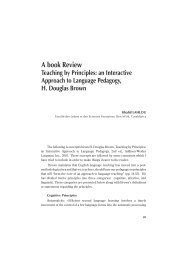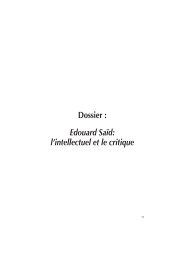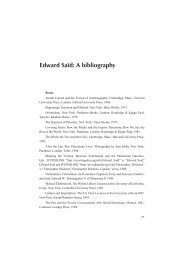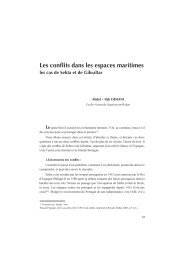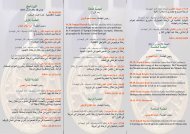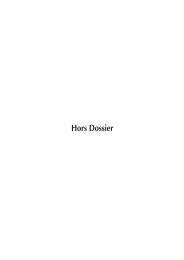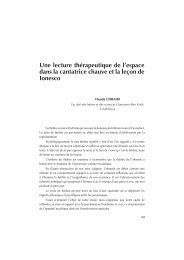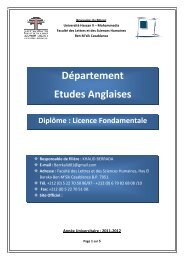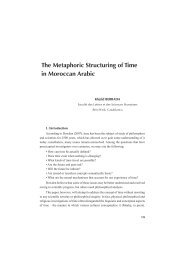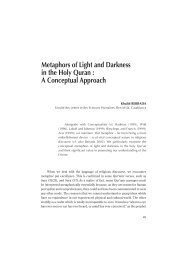Ech-charfi Ahmed
Ech-charfi Ahmed
Ech-charfi Ahmed
Create successful ePaper yourself
Turn your PDF publications into a flip-book with our unique Google optimized e-Paper software.
Spatial and temporal uses of Moroccan Arabic prepositionsSpatial and temporal uses ofMoroccan Arabic prepositions (1)<strong>Ahmed</strong> ECH-CHARFIFaculty of Education-Rabat1. Introduction.Correct use of prepositions is one of the most difficult problems that learnersof foreign languages have to face even after many years of formal instruction. Thisdifficulty is partly due to the lack of adequate and practical manuals, even for thelearning of international languages, including English and French. But the mostcrucial reason undoubtedly resides in the fact that the use of prepositions is underliedby cultural systems of belief about spatial, temporal and other relations expressed byprepositions. A learner of English as a foreign language has to know, for example, thatan island is considered in this language as a dimensionless point in order for him/herto produce correct structures such as “to live on an island” rather than incorrect onessuch as “to live in an island”, for example; the dictionary meaning of ‘on’, no matterhow detailed, will not provide the necessary information for an appropriate use of thepreposition.In this paper, I will attempt to address the issue of the spatial and temporal usesof Moroccan Arabic (MA) prepositions. Throughout the paper, I will be concerned1. I would like to thank Dr. El-Hakkouni of the faculty of Letters, Rabat for having read an earlier versionof this article. The present version owes a lot to his comments and suggestions. But I am the only oneresponsible for its shortcomings.111
Basamatwith the semantic distinctions between these prepositions and their Classical Arabic(CA) cognates. The focus will be particularly on metaphorical uses that uncover thecultural conceptions of space and time, and where divergence between MA and CA isfound, a comparison with Amazigh will be drawn in order to account for the semanticchange. MA and, until quite recently, Amazigh are unwritten languages which havebeen in contact with each other for a long period of time, long enough for the culturesthey express to contribute to their mutual shaping. Will the uses of their correspondingprepositions be found to reflect this common cultural background?2. Spatial uses.By indicating the place of an object, speakers give away their subjectiveconception of space. The attribute “subjective” here does not imply that each speakerhis his/her own conception or experience that may diverge widely from those of theother community members, but simply that, often, there is no single objective way ofreconstructing the characteristics of space. Whether a place is seen as a point or asa one-, two-, three-dimensional space depends not only on its geometrical form, butalso, and perhaps more importantly, on the uses that the speaker wants to make ofit for the purposes of communication. Yet, speakers cannot have complete freedomto develop singular, unconventional conceptions of places and to talk about them inthose terms; for otherwise communication would be hindered, if not totally broken.It is through a conventional conceptualization of space (and other) that communitymembers develop their own ethos/world-view.MA speakers do make quite singular uses of MA prepositions that cannot betranslated literally, not only into distant languages, but also into related ones such asCA of which MA is considered to be a variety. The major spatial meanings expressedby MA prepositions express will be discussed under three headings: position, relativeposition, and direction.2.1. Position: ‘f’, ‘cla’, ‘c∂nd’.Apparently, the prototypical uses of these three prepositions are to indicateposition in three-dimensional space in the case of ‘f’(in), two-dimensional space in thecase of ‘cla’(on) and zero-dimensional space in the case of ‘c∂nd’(at). The followingexamples illustrate these uses:1. nc∂s xalid f l-qism (Khalid slept in the classroom)2. g∂ls-at l-b∂nt cla l-kursi (The girl sat on the chair)3. tlaqa-w c∂nd l-bab (They met at the door)112
Spatial and temporal uses of Moroccan Arabic prepositionsA classroom is a place which has length, width, and height, whereas a chair(more precisely, a seat) has no height. As to ‘l-bab’(door) in (3), it does not denoteso much the board or even the frame as the dimensionless point near the door. In thissense, ‘l-bab’ serves merely as a reference point; that is why (3) could equally expressthe same meaning with other prepositions such as ‘g∂ddam’(in front) or ‘hda’(near).Thus, the basic meanings of ‘f’(in), ‘ c la’(on) and ‘ c ∂nd’(at) are best uncovered withnoun complements denoting three-, two-, and zero-dimension spaces, respectively.Unclear and borderline cases (i.e. cases where the dimensions are ambiguous) arenegotiated implicitly with reference to these prototypical uses, as will be explainedimmediately.Whether a noun can function as a complement of the preposition ‘f’(in) dependson whether its referent can be conceived as a three-dimensional place. Certainly,cognitive factors are crucial in this respect, but they are not sufficient to explainthe cross-language differences even among closely related languages. In MA, as inother languages, large two-dimensional spaces such as fields, gardens, pitches, etc.,are usually treated as three-dimensional, probably because they are so large that theentities being located in relation to them seem to be engulfed by them. Small spaceswith fences, barriers, sides, arms or any other edges also tend to be treated as threedimensional.A chair, for example, is two-dimensional when considered as a mere seat,but its back can add to it the dimension of height. Thus, ‘kursi’(chair) can be used withthe preposition ‘f’(in) as well as with ‘ c la’(on), as in (2) above. Such use, however,is not acceptable in CA, just as is unacceptable the use of the CA preposition ‘fī’(in)with nouns denoting relatively large flat objects such as carpets, roofs, tables, desks,etc. Yet, the CA preposition and its MA cognate do not differ in their core meaning (2) ;both of them are used prototypically with three-dimensional complements. What theydo not share is a set of non-prototypical, borderline cases, which are, nonetheless,too numerous to be listed here. This fact indicates that, while the core meaning ofspatial prepositions seems to resist change, their peripheral uses are less resilient andsuccumb relatively easily to acculturation.In comparison, the core meaning of ‘ c la’(on) is less clear-cut and not easilyamenable to succinct description. Although we have restricted its use to twodimensionnoun complements, what may be classified as one-dimension nouns areno less central to its use. There are some nouns which refer to entities with length2. For those who would not agree that two words from different languages may differ in, or have the same,meaning, the concept of ‘application’, as used by Lyons (1968:434), or ‘applicability’, as used by Lyons(1977:213) may replace ‘meaning’ in this, and similar, contexts.113
Basamatonly such as bicycles, motorcycles, horses (and other mounts), rods, etc. The widthand height of these entities are simply back-grounded. Such entities include Whetherone-dimension nouns are conceived of, by metaphorical extension, as two-dimensionnouns, or the latter are talked about in terms of the former, (or else the meaning of‘cla’ is vague) are questions we need not settle here. Suffice it to point out that manyMA predicates which take one-dimension complements correspond to CA predicateswhich do not need a preposition, as the following pair of examples illustrates:4-a. kāna rākib-an faRas-a-hu (CA)was.3ms riding-acc horse-acc-his(He was riding his horse)b. kan rak∂b c la c ∂wd-u (MA)was.3ms riding on horse-his(He was riding his horse)The change from predicates subcategorized for noun phrase complements(CA) to predicates subcategorized for prepositional phrase complements (MA) iscertainly not a random process, nor is it a mere side-effect of some grammaticalchange. On the contrary, the change has occurred at the conceptual level, and changeof subcategorization frames is a mere consequence of that change. The conceptualchange consists in classifying one-dimension nouns along with two-dimension nouns.Some probable causes of this process will be discussed in the last section of thispaper.By contrast, a comparison of the preposition ‘c∂nd’ and its CA cognate reveals thatthe two share many uses. In fact, their common uses far outnumber their divergences.This is probably because neither of them is subjected to much peripheral use, whiletheir core meaning is unambiguously restricted to zero-dimension position, as isillustrated by (3) above. Apparently, it is highly unlikely that a spot will be conceivedof any other way than as a zero-dimension place.2.2- Relative position: fuq/taht, muR/g∂ddam, da, m c a, bin.These prepositions express the position of an object in relation to another objector more. The following diagrams illustrate the basic meanings of these prepositions:a) fuq b) da c) bing∂ddam X muR X-A B A___X___Btaht114
Spatial and temporal uses of Moroccan Arabic prepositionsDiagram (a) illustrates the vertical and the horizontal relations of an object inrelation to X. The prepositions ‘fuq’ (on) and ‘taaht’ (under) express the verticalrelation, depending on whether an object is above or below X, respectively. Bycontrast, ‘g∂ddam’(in front) and ‘muR’(behind) express the horizontal relations onthe assumption that X has a front and a back. On its part, diagram (b) schematizesthe relation of closeness of A, compared to B, to X as expressed by the prepositionʻħdaʼ(near). And finally, diagram (c) shows the position of X in relation to A and B tobe ʻbinʼ(between).The above prepositions do not have the same form as their counterparts in CA. Inparticular, ʻg∂ddamʼ(in front) and ʻmuRʼ(behind), though etymologically derived fromCA words, their meanings are usually expressed by ʻ?amāmaʼ and ʻxalfaʼ, respectively.A similar remark can be made about ʻħdaʼ(CA ʻbi muħāðātʼ(beside)), which managedto displace CA ʻqurbaʼ(near) and become the preposition that expresses the relationof “nearness”. How the latter came to be replaced by the former is a question thathas very little relevance to our concerns in the present paper. However, both the MAprepositions and their corresponding CA cognates, though not sharing the forms,express more or less the same meaning, and differ only slightly in their use. Yet,the conception, for example, of what counts as the front or the back of an objectmay differ widely among the users of the respective languages. Whorf, for instance,explains that, where a relatively big rock stands between an individual and anotherobject, it is more appropriate for that individual to assert in English that the object isʻin frontʼ of the rock, and he is ʻbehindʼ it. In MA, it is rather the other way round.Since nobody speaks CA natively nowadays, it is difficult to check how a nativespeaker would express a similar statement (3) . Since ʻfrontʼ and ʻbackʼ, as used withinanimate objects, are metaphorical extensions, we would generally expect languagesto vary substantially in this respect. More will be said about these prepositions in thefollowing section.On its part, the preposition ʻm c aʼ, when used for relative position, presents arather curious case. It seems that it basically expresses accompaniment, though thisconcept is not restricted only to human or even animate entities, but also to someinanimate objects, as is illustrated by the following example:5) Ra-h waq∂f m c a Saħb-u/ l-ħiT/ l-*∂žRa/l-poTo3. One possible way to gain some insight into the issue is to search for relevant evidence in the work ofearly Arab writers; but this task would take us beyond the scope of the present paper.115
Basamatthere-3ms standing with friend-his/def-wall/def-tree/def-post(He is standing with his friend/against the wall/tree/post)As the English translation of (5) shows, ‘m c a’ does not always correspond to‘with’, since it is not appropriate to say in English that a person is standing ‘with’ apost, for example. Yet, ‘against’ does not render the exact meaning of ‘m c a’ in suchcases, for ‘mca’ does not presuppose any physical contact with the reference object. Itmay be claimed that ‘m c a’ and ‘with’ do not correspond exactly to each other simplybecause they have different sense relations, as is the case with all vocabulary items.I would rather say that the divergences between the two prepositions exemplified by(5) above are not due to their meanings, but to the different cultural conceptions ofobjects having a certain degree of height. In MA, walls, trees, posts, and other objectsof similar height are spoken about as if they take an erect posture. They can stand orfall, in the same way that humans and other animates can. In this respect, the use ofMA ‘m c a’ differs not only from the English ‘with’, but also from its correspondingCA preposition. In CA, just like in English, it is not appropriate to say that somebody is standing ‘with’ the wall, the tree, etc. The quite singular use of ‘m c a’ will beillustrated further in the next subsection.2.3- Direction: mn/l, fuq/taht, g∂ddam/muR, m c a.If the prepositions discussed so far express (relative) position when they are usedwith ‘state’ predicates, those of them which can be appropriately used with predicatesof ‘motion’ also express direction. Generally, they specify the point of departure andthe destination of an entity, as well as other reference points of the movement.Perhaps the best examples of prepositions of direction are ‘mn’(from) and‘l’(to). Like their English equivalents, and much more like their CA cognates, theseprepositions signal departure and destination, respectively. When two points ofreference are both the point of departure and the destination, ‘bin’(between) is used,as in (6):6) ka-iSafR bin kaZa u l-RbaTImp-travels.3ms between Casablanca and def-Rabat(He travels a lot from Casablanca to Rabat and back again)This use of the preposition ‘bin’ to express direction is less frequent than themore basic use of relative position discussed in the preceding section. This fact doesnot hold for all similar prepositions, however.Most of the prepositions that express relative position can also express direction.Under the latter use, they specify the path of the movement by providing a reference116
Spatial and temporal uses of Moroccan Arabic prepositionspoint; i.e. by locating the moving entity in relation to another entity or place. Thefollowing example is illustrative:7) daz fuq/ t∂ħt/ g∂ddam/ muR l-k°dyawent.3ms over/below/in front of/behind def-hill(He went over/below/from this side/on the other side of the hill)The fact that these prepositions are equally appropriate with ʻmovementʼpredicates as with ʻstateʼ predicates indicates clearly that their meaning is neutral tomovement or lack of it. Their meaning is restricted to the specification of the types ofhorizontal or vertical relation of an object vis-à-vis a reference point.So is the case with the preposition ʻmcaʼ(with). As with ʻstateʼ predicates, ʻmcaʼis used in a very singular way with predicates of movement. If it expresses relativeposition in relation to vertical entities, with horizontal entities, it expresses direction.This is best illustrated by the following:8) m * a m c a l-TRiq/ l-sT∂R/ l-ħiT/l-wadwent.3ms with def-road/def-line/def-wall/def-river(He went along the road/line/wall/river)In this example, ‘m c a’ is best rendered by the English preposition ‘along’.Neither its English equivalent ‘with’, nor its CA cognate ‘ma c a’ can take acceptablycomplement nouns such as those in the example above. Again, this is not dueto their different sense relations, nor to vagueness or any other semantic concept.As it appears to me, both ‘m c a’ and its English or CA equivalent express the samemeaning: accompaniment. What is singular about ‘m c a’ is not so much its meaningas the conception of what can accompany what. As with vertical objects, which areconceived by way of metaphorical extension as taking an erect posture, so are longhorizontal entities conceived as moving. In MA, a traveler does not go along theroad; rather, the traveler and the road go together. Indeed, it is not only possible tosay in MA that a road ‘goes’ to a certain destination, ‘passes’ through a landscape orby a landmark, and ‘turns’ left or right at a certain point, but I can think of no otherway to express the same ideas in this language. Therefore, it seems that the use of apreposition is not determined solely by its meaning, but also by the meaning of itscomplement, which may be laden with cultural content.All in all, although the physical characteristics of space are accessible to thesenses, the spatial uses of prepositions in related and unrelated languages may differwidely. This divergence is the result not only of the number of prepositions, whichvaries from one language to another, but also of the different cultural conceptions117
Basamatof space. The cultural factor is expected to be more prevalent and more obvious inabstract relations in which case the senses are of very little help. Such is the case oftime, to which we turn immediately.3. Temporal uses.MA objectifies time, just like CA or what Whorf (1939) calls “Standard AverageEuropean” (i.e. languages), or maybe all the languages of the Near East and theMediterranean which have been in direct or indirect contact with each other sinceprehistory. In these languages, the time cyclicity is dissected into time units (viz.days, months, years, etc.) which can be counted, identified in relation to each other,and more importantly, used to identify other events. Speakers of these languagesare so accustomed to talking about days, for example, in the way they talk aboutfriends, stones or any other quantifiable entity that they can envisage no other wayto do so. However, Whorf (1939) has pointed out that Hopi and other Amerindianlanguages do not count time units because these are not even nouns. According toWhorf (1939:143), “they are a formal part of speech by themselves, distinct fromnouns, verbs, and even other [...] adverbs.” Yet, although the languages of the OldWorld treat time in a common way that differs radically from that of the languages ofthe New World, they also differ from each other in many respects. The bulk of thesedifferences (or similarities) is uncovered by the temporal uses of prepositions. Thediscussion below provides some illustrations.3.1. Time as container.Most time expressions in MA can co-occur with the preposition ‘f’(in). Aswas explained in the preceding section, this preposition is used basically to expresslocation in a three-dimension space. Apparently, the use of this preposition with timeexpressions is a metaphorical extension of the spatial meaning. Let’s consider thefollowing example:9) ka-ixd∂m f l-Sbaħ/ l-lil/ l-Sif/ maRSImp-work.3ms in def-morning/def-night/def-summer/March(He works in the morning/the night/summer/March)Since these time expressions refer to periods of time, they seem to be treated onthe same footing as spatial expressions such as ‘forest’, ‘room’, or even as ‘field’,‘city’, etc. An event is said to happen, so to speak, in such periods of time. Like aplace, a period of time is also circumscribed by edges or borders, though these may beequally fuzzy for time as for space. Thus, a day, for example, is the period that lasts118
Spatial and temporal uses of Moroccan Arabic prepositionsʻmn l-Sbaħ l-c*iyaʼ(from the morning to the evening), or that which is ʻbin l-Sbaħu l-c*iyaʼ(between the morning and the evening). Again, a time period is spoken ofin terms of expressions of space and defined as the ʻdistanceʼ between a point andanother. Up to this point, MA seems to have a lot in common with CA and English andmany other languages as far as the temporal uses of prepositions are concerned.However, some points of divergence are to be noted. For example, both CA andEnglish treat moments of time as ʻpointsʼ, as is revealed by the use of the prepositionsʻcindʼ in CA and ʻatʼ in English. In MA, the corresponding preposition ʻc∂ndʼ isunacceptable with complements denoting specific moments of time. Indeed, a fewother prepositions are used in these contexts, among which is ʻfʼ(in), as illustrated by(10):10) mat f l-s∂bca/ l-fž∂r/ r∂m*∂t cindied.3ms in def-seven/def-dawn/wink.Gen eye(He died at seven/dawn/in a wink=quickly)The use of ʻfʼ(in) in this example seems to indicate that moments are alsoconceived in MA as ʻcontainersʼ of events, much like periods. In a tradition wheretime is often depicted as a line on which ʻpoints of timeʼ are marked, examples like(10) are rather peculiar. But alternatives to the linear representation of time are quiteconceivable, as will become clear when we consider other prepositions.3.2. Time as companion.The reader must recall the use of the preposition ʻmcaʼ(with) with complementsdenoting long horizontal objects such as roads, rivers, lines, channels, etc. to expressaccompaniment. It was pointed out in this connection that these objects are conceivedof in MA as moving along with other entities being located in relation to them. It isoften the case that the same preposition can also be used with time expressions ascomplements, as the following example testifies:11) f∂q-t mca l-tlata/ l-fž∂r/ Tluc l-*∂m*woke-1s with def-three/def-dawn/rise def-sun(I woke up at three/dawn/sunrise)Some of the prepositional complements in this example obviously denote events.Such is the case of ʻTluc l-*∂m*ʼ(sunrise). At least in such cases, there is a sense inwhich the preposition ʻmcaʼ expresses simultaneity of two actions, e.g. the processesof rising from bed and sun rising happened simultaneously. In some cases, it ispossible to omit the action noun when the subject and the prepositional complementare understood to do/have done the same thing, as in (12):119
Basamat12) b∂yy∂t mca l-TyuRslept.3ms with def-birds(He went to bed at the same as birds)As the English translation suggests, (12) does not mean that the person in questionslept with birds, but only that he went to bed as early as birds get back to their nests.If the prepositional complement in this example is replaced by a time expression suchas ʻl-s∂bcaʼ(seven), the sentence would mean something like: His going to bed and theclock striking seven happened together.There is some evidence in support of this apparently unusual interpretation.Firstly, while the preposition ʻmcaʼ(with) does occur with expressions denoting pointsof time, it cannot occur with expressions denoting relatively long periods. Thus, thefollowing example would not be well-formed if the more usual preposition ʻfʼ(in) isreplaced by ʻmcaʼ:13) ka-iSaf∂r f/*m c a maRS/ l-Sif/ l-wikandImp-travel.3ms in/*with March/def-summer/def-weekend(He leaves on holiday in March/summer/the weekend)It seems that accompaniment is excluded between long actions and periods oftime. Secondly, even when ʻmcaʼ occurs with periods instead of points of time, thereis a difference between the meaning this preposition would issue and that of ʻfʼ(in).In (14), for example, ʻfʼ indicates that the person in question arrived sometime in themorning, between early morning and midday; whereas ʻmcaʼ can only be interpretedas meaning early morning:14) wS∂l f/m c a l-Sbaħarrived.3ms in/with def-morning(He arrived (early) in the morning)On the other hand, when the time expression denotes an event/action used as atime reference, only ʻmcaʼ is acceptable, as (15) shows:15) ža mca/*f Tlu c l-*∂m*came.3ms with/*in rise def-sun(He came at sunrise)Here, sunrise is considered as an event, not as a period or as a point in time;therefore, it is not congruent with ʻfʼ(in). By contrast, ʻmcaʼ indicates clearly thatthe action of coming (or, more precisely, arriving) and sunrise happened at the sametime. The last piece of evidence concerns the way of speaking about units. In MA, it is120
Spatial and temporal uses of Moroccan Arabic prepositionsperfectly acceptable to say of two events that they ʻcameʼ (i.e. happened) ʻtogetherʼ, asin the examples below, where it is possible for the noun phrases to exchange positionswithout much effect on the meaning of the sentence:16) a- ža l- c id mca Ras l-camcame.3ms def-Aid with head def-year(The Aid was celebrated on New Yearʼs Day)b- ža R∂mDan u l- c uTla m c a b∂ c Diyat-humcame.3ms and def-holiday with some-their(Ramadan and the holiday came with each other=at the same time)It is obvious from these, and other similar, examples that time ʻhappensʼsimultaneously with events, and that this simultaneity is expressed not only by thepreposition ʻm c aʼ, but also by other ways of speaking exemplified by (16) where thesame metaphor is perhaps more perspicuous.The temporal use of the preposition ʻm c aʼ(with) to express accompaniment, likeits spatial use, has been shown to be quite singular, when compared with the Englishequivalent or with the more related CA cognate. Once again, we reiterate the argumentalready advanced above that the different uses of the corresponding prepositions inthese languages cannot be accounted for only by their sense relations (or meaning),but more importantly by the different cultural conceptions of simultaneity of eventsand time. The next subsection will show that distant languages may exhibit similaritiesthat may not be found in related languages.3.3. Time as a traveler.Lakoff & Johnson (1980:Chap.9) have shown that English organizes time in sucha way that the future is in front and the past is behind. Time is spoken of as if it ismoving in the opposite direction of people, or as if it is stationary while people aremoving through it. Much of their description holds also for MA.In MA, as in English and CA, the identification of the here-and-now, or indeedall sorts of events, is made metaphorically in terms of spatial relations. Thus, an eventis ʻnearʼ the present or ʻfar awayʼ into the future or the past, another ʻhas comeʼ (wS∂l)or ʻis goneʼ(fat), days ʻare goneʼ and others ʻhave comeʼ (m*at yyam u žat yyam).Yet, time does not wander in every direction. Time is a traveler who is ʻwalkingʼand sometimes ʻrunningʼ on a straight line, not to by-pass people, but to reduce theʻdistanceʼ between them and the future events which function much like milestones.To this purpose, time is moving in the opposite direction. In MA (or should we sayMoroccan culture?), it is often time that moves while people, like things, are stationary.121
BasamatIt is only after moments of reflection, as on the occasion of a personʼs death, thatMoroccans express the wisdom that time is eternal and that it is their lives that arecorroded by the passage of the ʻuntrustworthyʼ time.Time is also personified as if it has a face and a back. While CA has a pair oftime prepositions indicating anteriority (viz. ʻqablaʼ(before)) and posteriority (viz.ʻba c daʼ(after)), MA makes little use of their cognates ʻqb∂lʼ and ʻb∂ c dʼ, which areoften replaced by their corresponding spatial prepositions ʻg∂ddamʼ(in front) andʻmuRʼ(behind), respectively. The front of a future event is nearer to the present thanthe front of a past event, while the back of a future event is farther from the presentthan that of a past event. This fact is illustrated clearly by the following figure:Past _____Event_______present_________Event________Futureg∂ddam muRg∂ddam muRThe use of these prepositions uncovers the tacit conception of events as travelersfacing individuals, but as soon as these events are over, they turn their back to them,and continue their way in the same direction. This conception is perfectly coherentwith the idioms discussed in the preceding paragraph, and many others not mentionedhere because of space and time constraints. Therefore, what is crucial is the underlyingconception which is only partly uncovered by the temporal uses of prepositions. It isthis implicit principle that makes these uses of prepositions highly structured andpredictable.It should be pointed out that there is nothing natural about the above mentionedconception of time. If two languages as distant as MA and English express the sameconception of time, this by no means implies that all languages will also share thischaracteristic. Besides, there are many features that set MA apart from English andeven from CA. for example, both English and CA have time prepositions, but do nothave recourse to spatial prepositions to express anteriority and posteriority, as MAdoes. In English and CA, what uncovers the metaphor of time as a moving objectis not so much the use of prepositions as the use of other expressions such as “thepreceding ...”, “the following ...”, etc., when used with time expressions. One mayventure to say that the time metaphor is more articulated in MA than in English orCA. The question that needs to be answered here is: Why should MA make littleuse of (or even dispense with) the time prepositions it has inherited from CA whenthese are more efficient in expressing time relations than the corresponding spatialprepositions? I shall try to find a possible answer right away.122
Spatial and temporal uses of Moroccan Arabic prepositionsAcculturation.Now that we have presented some facts about the spatial and temporal uses of MAprepositions, and after we have discussed the metaphors which underlie the varioususes of these prepositions, two different but related questions need to be raised. First,how come that MA prepositions can sometimes be used in such a distinct mannerfrom their CA cognates as if the two languages were unrelated. Second, is it really thecase that the uses of prepositions reveal a certain world-view or is the whole mattercompletely arbitrary? The two questions will be answered separately in the followingsubsections.4.1. The Amazigh effect.Historical linguists have been more concerned with ʻblindʼ sound changesthan with semantic changes affecting individual lexical items. But it is the semanticaspect of language that brings linguistics together with the other behavioral sciences.Concerning language contact, the phenomenon of borrowing has traditionally receivedfar more attention than semantic calques in view of the dramatic effect it may haveon the phonological system of the recipient language, especially if the number ofunassimilated loans is very great. Yet, the cultural system may infiltrate not only therecipient language, which is often the language of the less powerful culture, but thedonor language, which is usually the language of the dominant culture, may ultimatelysuccumb to the weaker culture.Such seems to be the case of MA. Apart from some sound changes that haveresulted in a few cases of homophonous prepositions, MA has inherited the CAprepositional system in its entirety. No foreign preposition has been introduced into thelanguage. Yet, MA prepositions sometimes diverge semantically so widely from theirCA cognates that the only thing that seems to relate them to each other is their form.What is the reason behind this drastic change? The answer seems to come from contactwith the Amazigh language. Arabic was introduced gradually in Morocco throughoutlong periods of history, first by conquerors and then by successive waves of migrants.But the number of the native Amazigh speakers remained, until relatively recently,larger than that of native Arabic speakers. This fact indicates that a large number ofthose who speak MA natively today are either children of Amazigh-Arabic bilingualsor are themselves bilinguals in the two languages. It would be worth consideringthe question of whether MA and Amazigh share some of the uses of prepositionsdiscussed above.To begin with, there are no temporal prepositions in Amazigh. Anteriority andposteriority are expressed by the spatial prepositions denoting the ʻfrontʼ and ʻbehindʼ123
Basamatrelations, respectively. This is in total agreement with the fact that MA makes littleor no use at all of the temporal prepositions inherited from CA. In fact, it is probablethat different speakers make different uses of these temporal prepositions and theircorresponding spatial ones. If this is the case, it is expected that bilinguals will usetemporal prepositions less often than monolinguals will, and that among monolingualsthemselves, those who contact Amazigh-speakers frequently will use such prepositionsless often than those who do not.Most of the divergences between MA and CA pointed out in the precedingsections can be explained by the formerʼs contact with Amazigh. For example, the useof the preposition ʻmcaʼ(with) to express simultaneity is also attested in Amazigh. Inthis language, the preposition ʻagðʼ(4) (with) is often used instead of ʻgʼ(in) to indicatethat two events happened at the same time, and that points of time are also events thatʻoccurʼ. Some typical cases are provided in (17):17) bði-x agð ss∂b c a/θifawθ/unbðustart-1s with seven/morning/summer(I started at seven/early in the morning/early in summer)Like the MA example in (11) above, (17) indicates that the action of startinghappened simultaneously with the following temporal reference points. It is for thisreason that ʻθifawθʼ and ʻunbðuʼ, as the English translation indicates, are understoodto mean ʻearly in the morningʼ and ʻearly in summerʼ, respectively. In comparison, theuse of the preposition ʻgʼ(in) would mean that the event happened somewhere in themiddle of the periods in question.Similarly, while the MA ʻm c aʼ, as a spatial preposition, is semantically differentfrom its CA cognate, it matches perfectly with its Amazigh equivalent ʻagðʼ. Likeʻm c aʼ, ʻagðʼ is used to locate two entities in a vertical position in relation to each other.The example in (8) above, repeated here for the sake of convenience, translates easilyinto Amazigh, almost word for word, whereas a similar translation into CA wouldrequire the substitution of the preposition by another one:8) m*a m c a l-TRiq/ l-sT∂R/ l-ħiT/l-wadwent.3ms with def-road/def-line/def-wall/def-river(He went along the road/line/wall/river)This remark is equally true for the use of this preposition with long entities ina horizontal position to express direction. In Amazigh, as in MA, it is quite normalto say that a person is going ʻwithʼ a road/river/line, etc. Moreover, this type ofAmazigh prepositional phrases occurs not only with the verb ʻdduʼ(go), but also, and124
Spatial and temporal uses of Moroccan Arabic prepositionsmore frequently, with the verb ʻmunʼ (accompany). This fact suggests that in thislanguage, the road and the traveler are conceived of as companions; after all, the wordfor ʻcompanionʼ in Amazigh is derived from this verb by prefixation (viz. ʻasmunʼ).Examples in which MA and Amazigh prepositions are used in exactly the same wayare numerous. What needs to be done is to explore the relevant implications of thisalmost perfect prepositional matching between MA and Amazigh.4.2. Metaphorical coherence.A number of questions impose themselves on the analyst when faced with suchkind of data as we have discussed in this paper. Among such questions are: Are thesephenomena simply an aspect of interference, just like phonological or grammaticalinterference, generally noticed in bilinguals as a result of imperfect learning? If not,in what respect does semantic interference differ from the other types of interference?Does the use of prepositions really reflect some underlying conceptions (of timeand space, for example) or is it arbitrary? If the use of prepositions does reflect suchconceptions, what kind of relationship is there between these conceptions and thelinguistic expressions in which they are couched? No exhaustive answers to thesequestions will be attempted here, but some treatment of our data must be provided inthe light of these theoretical concerns.First of all, the metaphorical uses of MA prepositions discussed above arecoherent. To take the example of ʻm c aʼ(with) once again, this preposition is consistentnot only with the established uses, but also with innovative ones. Thus, it may bethat such expressions as “to stand ʻwithʼ the tree or the wall” have been handeddown through generations, but the occurrence within similar expressions of nounsdenoting new objects (e.g. MA ʻpoToʼ post) must surely indicate the existence of somestructuring principle. Similarly, the fact that ʻa lineʼ (on paper) is treated in MA in thesame way as a road or a river points to a similar conclusion, for writing on paper, andmuch less on lined paper, was not very much in use among Moroccans in the past.If someone says in MA something equivalent to “X is standing with his garden” or“X is walking ʻwithʼ his field”, he will be immediately spotted out as a non-nativespeaker. Does this simply indicate that that he has not yet grasped the meaning ofthe preposition ʻm c aʼ(with)? Without going into the interminable debate concerning4. The term Amazigh is a recent coinage to refer to a continuum of sometimes unintelligible dialects.This continuum was traditionally divided into three major dialect groups known as Tarifit, in the north ofMorocco, Tamazight in the middle, and Tashlhiyt, in the south. In this paper, reference will be made to theTamazight variety.125
Basamatmeaning, sense, intension, extension, etc., I believe that there is more to the issue thanjust learning the meaning of a preposition; the non-native speaker will have failed toassimilate the geometrical characteristics of things that can be said in MA to ʻstandʼor ʻgoʼ. That is why I have occasionally pointed out above that the appropriate use ofa preposition is not determined only by the sense relations of that preposition, but alsoby the nouns with which it can combine, i.e. to form permissible collocations.Furthermore, the fact that some of the prepositional uses in MA are metaphoricalis corroborated by independent evidence. For instance, the use of ʻm c aʼ(with) incombination with nouns denoting vertical or horizontal objects is further supportedby other expressions indicating that these objects are conceived of as ʻstandingʼ orʻgoingʼ. These are some illustrative examples:18) a-w∂qqf-u /T∂yyħ-u /n∂εεs-u/ l-poToPut up-3mp/put down-3mp/lied-3mp/ def-post(They have put up/lied down the post)b-žay-a/ ġad-a l-TRiq T∂wwalacoming-fem/going-fem def-road straight(The road is straight)The verbs ʻwq∂fʼ(stand up),ʼw∂qq∂fʼ(put up) and the participle ʻwaq∂fʼ(standing)are used indistinguishably with animate as well as with inanimate entities. Similarly,the participles ʻžayʼ(coming) and ʻġadiʼ(going) used in (18b) with ʻTRiqʼ(road), areitems that can also be used with animate subjects. This argument has already beenmade at different points in this paper, not only in connection with MA, but also withAmazigh, and the examples from both languages could be multiplied. It remains tobe pointed out that, if a preposition is used in a similar manner in both languages, it isbecause the same metaphors underlie and structure the conceptions of space and timein these languages.Indeed, if such metaphors can be claimed to uncover the world-view (i.e. culture)of a people, then both MA and Amazigh can be claimed to reflect one and the sameculture (viz. the Moroccan culture), considering that the two languages share a largenumber of metaphors similar to those exemplified in this paper. If this argument istenable, it could be held that culture, or at least part of it, exists independently of thelanguage in which it is couched. In other words, when Arabic-speakers in Moroccostarted to use items of their language in ways other than those prescribed by theirlinguistic system, they had already assimilated a different world-view. How the processof assimilation or acculturation was activated and by what means it was carried out isbeyond the scope of this paper, and I will not pursue this point any further.126
Spatial and temporal uses of Moroccan Arabic prepositionsTo sum up, the following points should be retained from the preceding discussion.First, metaphorical uses of MA prepositions reveal some underlying conceptionsof spatial and temporal relations, and these uses are consistent with other types ofmetaphorical expressions denoting space and time. Second, while MA has a lot incommon with Amazigh in terms of preposition use, its divergences from CA arewide. This fact is indicative of the impact of Amazigh on MA even in cases wherelexical borrowing is not involved. The implications of these findings on the relationof language and culture, though slightly touched upon in the present paper, need to beinvestigated in more depth in future research.5. Conclusion.This paper has been concerned with the spatial and temporal uses of MAprepositions, with special focus on metaphorical extensions that reveal some tacit,but significant, conceptions of space and time. In this respect, the distinction betweenʻmeaningʼ and ʻuseʼ emerges as a necessary theoretical tool in order to account forMA prepositions. More specifically, the appropriate use of these prepositions is notdetermined by their meaning alone, but also by the noun phrases that can functionas their complements. Since MA prepositions differ widely from their CA cognatesin use (though not necessarily in meaning), and match perfectly with their Amazighequivalents, the conclusion that MA and Amazigh reflect the same world-viewseems logical. It follows that the change exhibited by the semantics (or shall we sayʻpragmaticsʼ?) of MA prepositions must have been preceded and caused by culturalchange. Further research in the domain of foreign language acquisition will certainlycontribute to a deeper understanding of the relation between language and culture.ReferencesCarroll, J.B.(ed.) (1956) Language, Thought and Reality, Selected Writings ofBenjamin Lee Whorf. MIT Press, Cambridge, MassachusettsLakoff, R. & Johnson, M. (1980) Metaphors We Live By. The University ofChicago Press, Chicago.Lyons, J. (1968) Introduction to Theoretical Linguistics. Cambridge UniversityPress, Cambridge.Lyons, J. (1977) Semantics. Cambridge University Press, Cambridge.Whorf, B.L. (1939) “The relation of habitual thought and behavior to language”;in Carroll (ed.) (1956), pp:134-159.127



